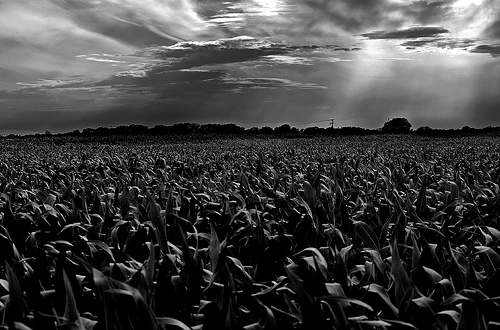The Congressional Budget Office just released a paper looking critically at the relationship between ethanol, food prices and carbon emissions. But it gets better. The CBO blogged about it! Bedtime for corn ethanol?Photo: Big Grey Mare
Bedtime for corn ethanol?Photo: Big Grey Mare
Most ethanol in the United States is produced from domestically grown corn, and the rapid rise in the fuel’s production and usage means that roughly one-quarter of all corn grown in the U.S. (nearly 3 billion bushels) is now used to produce ethanol. The demand for corn for ethanol production has exerted upward pressure on corn prices and on food prices in general. CBO estimates that the increased use of ethanol accounted for about 10 percent to 15 percent of the rise in food prices between April 2007 and April 2008.
In turn, increases in food prices will boost federal spending for mandatory nutrition programs such as the Supplemental Nutrition Assistance Program (SNAP, formerly known as Food Stamps) and the school lunch program by an estimated $600 million to $900 million in fiscal year 2009. The Special Supplemental Assistance Program for Women, Infants, and Children–better known as WIC–is a discretionary program that provides a specific basket of goods to recipients rather than a set cash benefit, so changes in food prices in 2008 had an immediate impact on costs for the program. Under the assumption that the effects are much the same, increased production of ethanol would have added less than $75 million in fiscal year 2008 to the cost of serving the same number of WIC participants as in 2007.
Last year the use of ethanol reduced gasoline usage in the United States by about 4 percent and greenhouse-gas emissions from the transportation sector by less than 1 percent. The future impact of ethanol on greenhouse-gas emissions is unclear. Research suggests that in the short run, the production, distribution, and consumption of ethanol will create about 20 percent fewer greenhouse gas emissions than the equivalent processes for gasoline. In the long run, if increases in the production of ethanol led to a large amount of forests or grasslands being converted into new cropland, those changes in land use could more than offset any reduction in greenhouse-gas emissions–because forests and grasslands naturally absorb more carbon from the atmosphere than cropland absorbs. In the future, the use of cellulosic ethanol, which is made from wood, grasses, and agricultural plant wastes rather than corn, might reduce greenhouse-gas emissions more substantially, but current technologies for producing cellulosic ethanol are not yet commercially viable.
Apologies for the long quote, but when bureaucrats speak with such venom, it’s hard to resist. Okay, maybe it only reads as venomous if you’re an ethanol lobbyist or House Ag Chair Rep. Collin Peterson. I especially liked the direct linkage between ethanol’s effects on food prices and the increased cost to the government via the school lunch program. And hearing a government agency expressing real concern over land-use issues surrounding ethanol is music to my ears. Even the future value of cellulosic ethanol is questioned. It’s all good.
Bonus: Once you start pitting interest groups against each other (i.e. nutrition vs. ethanol), you have a much better chance of finding the political will to attack wasteful programs. This a pretty loud clarion call that the end is nigh for corn ethanol’s Congressional free pass.



